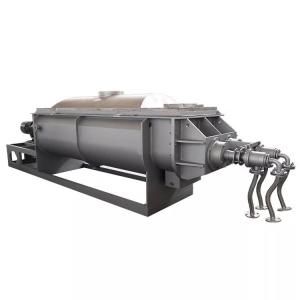

Add to Cart
Factory Price Hollow Paddle Dryer Sludge Drying Machine
Application
The paddle dryer has been successfully used in food, chemical,
petrochemical, dye, industrial sludge and other fields. The heat
transfer, cooling, and agitation characteristics of the equipment
enable it to perform the following unit operations: calcination
(low temperature), cooling, drying (solvent recovery), heating
(thawing), reaction, and sterilization. The agitating blade is also
a heat transfer surface, which increases the heat transfer area per
unit effective volume and shortens the processing time. The
wedge-shaped blade heat transfer surface has a self-cleaning
function. Compression - the expansion and agitation function makes
the material mix evenly. The material moves in a "plug flow" along
the axial direction, and the temperature, humidity, and mixing
gradient of the material are small in the axial interval.
Technical parameters
| Item | WKS-P3 | WKS-P9 | WKS-P13 | WKS-P18 | WKS-P29 | WKS-P41 | WKS-P52 |
| Model | |||||||
| Heating area(m2) | 3 | 9 | 13 | 18 | 29 | 41 | 52 |
| Effective area(m3) | 0.06 | 0.32 | 0.59 | 1.09 | 1.85 | 2.8 | 3.96 |
| Speed(rmp) | 15 to 30 | 10 to 25 | 10 to 25 | 10 to 20 | 10 to 20 | 10 to 20 | 10 to 20 |
| Power(kw) | 2.2 | 4 | 5.5 | 7.5 | 11 | 15 | 30 |
| Machine width A(mm) | 306 | 584 | 762 | 940 | 1118 | 1296 | 1476 |
| Total width B(mm) | 736 | 841 | 1066 | 1320 | 1474 | 1676 | 1854 |
| Machine width C(mm) | 1956 | 2820 | 3048 | 3328 | 4114 | 4724 | 5258 |
| Total length D(mm) | 2972 | 4876 | 5486 | 5918 | 6808 | 7570 | 8306 |
| Distance (feeding to discharge) E(mm) | 1752 | 2540 | 2768 | 3048 | 3810 | 4420 | 4954 |
| Central height F(mm) | 380 | 380 | 534 | 610 | 762 | 915 | 1066 |
| Total height H(mm) | 762 | 838 | 1092 | 1270 | 1524 | 1778 | 2032 |
Equipment characteristics
1. The energy consumption of the blade dryer is low: due to
indirect heating, there is not a large amount of air carrying heat,
and the outer wall of the dryer is provided with an insulation
layer. For the slurry material, only 1.2 kg of water vapor is
required to evaporate 1 kg of water.
2. The blade dryer system has a low cost: it has a huge heat
transfer surface in the effective volume, which shortens the
processing time and reduces the size of the device. It greatly
reduces the building area and building space.
3. Wide range of processing materials: Different heat media can be
used to process both heat sensitive materials and materials
requiring high temperature treatment. Commonly used media are:
water vapor, heat transfer oil, hot water, cooling water, etc. It
can be operated continuously or intermittently and can be applied
in many fields.
4. Small environmental pollution: no air is used, and dust
materials are rarely entrained. The solvent evaporation of the
material is small and easy to handle. Closed loops can be used for
contaminated materials or for conditions requiring recovery of
solvents.
5, low operating costs: the device operates normally, only 1 hour /
day · people. Low speed mixing and reasonable structure. The amount
of wear is small and the maintenance cost is low.
6. Stable operation: Due to the special compression-expansion and
agitation of the wedge-shaped blade, the material particles are
fully in contact with the heat transfer surface. In the axial
interval, the temperature, humidity and mixing gradient of the
material are small, thus ensuring Process stability.
Introduction
The wedge type hollow paddle dryer can indirectly heat or cool the
paste, granular, powder and slurry materials, and can perform unit
operations such as drying, cooling, heating, sterilization,
reaction, low temperature calcination and the like. The special
wedge-type agitating heat transfer paddle in the equipment has high
heat transfer efficiency and self-cleaning function of the heat
transfer surface.
A wedge-shaped hollow blade is densely arranged on the hollow
shaft, and the heat medium flows through the blade through the
hollow shaft. The heat transfer area in the effective volume per
unit is large, and the temperature of the heat medium is from -40 °
C to 300 ° C. It can be water vapor or liquid type: such as hot
water and heat transfer oil. Indirect conduction heating, no air is
carried away to remove heat, and heat is used to heat the material.
The heat loss is only the heat dissipation to the environment
through the insulation of the body. The wedge-shaped blade heat
transfer surface has a self-cleaning function. The relative
movement of the material particles and the wedge surface produces a
scrubbing action, which can wash away the adhering material on the
wedge surface, so that a clean heat transfer surface is maintained
during operation. The housing of the paddle dryer is W-shaped, and
two to four hollow agitator shafts are generally arranged in the
housing. The housing has a sealed end cap and an upper cover to
prevent material dust from leaking out and collecting material
solvent vapor. A baffle is arranged at the discharge port to ensure
the height of the material level, so that the heat transfer surface
is fully covered by the material. The heat transfer medium passes
through the rotary joint and flows through the casing jacket and
the hollow agitating shaft. The hollow agitating shaft has
different internal structures according to the type of the heat
medium to ensure an optimal heat transfer effect.
